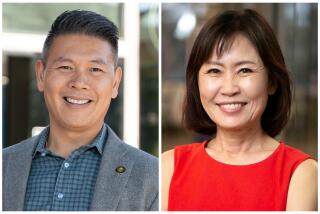FULLERTON : Tests Conducted for Marrow Transplant
- Share via
Hanh Truong’s well-wishers lined up like lottery players Tuesday, each baring a vein on the 1-in-100,000 chance that the young man could be kept alive.
The 29-year-old computer programmer is suffering from acute lymphocytic leukemia, a bone-marrow cancer. He has been given only a 30% chance of survival unless he receives a bone-marrow transplant within the next two years.
But finding a bone-marrow donor is proving a particularly thorny problem for the Vietnamese-born Truong because his relatives have proven to be incompatible and the pool of possible Vietnamese donors in the United States is so small.
To survive, Truong must battle not only the medical odds but a traditional reluctance among many Southeast Asians to give blood--or to go on television or even around the neighborhood to ask strangers to give bone marrow.
“At first, when the doctor told me I had to go back to my community to start a blood drive. . . , I was very reluctant,” Truong said. “It was hard, because being Asian, you keep everything to yourself, you deal with it in the family. You don’t come out and say, ‘I’m sick and need help.’ ”
But Truong said he now hopes that going public with his own plight may help other leukemia victims who are dying in silence.
“I have three friends who say they know someone who has leukemia. . . . They don’t come out and ask for help. So they die instead of saying something,” Truong said.
“Even if this event does not come up with bone marrow for me, I hope it will find a match for somebody else,” he said. “That would be the greatest.”
Tuesday’s drive was held at Cal State Fullerton, Truong’s alma mater, and sponsored by the Covina-based Life-Savers Foundation of America. Family and friends had also distributed 20,000 leaflets in Orange County’s Vietnamese community in hopes of attracting more Asian donors.
Nearly 170 people from the college and the community had dropped by for testing. Life-Savers data banks contain information on 107,000 potential bone-marrow donors nationwide, but only about 4% of them are Asian, and perhaps only 1% Vietnamese, said Charles E. Pruitt, donor-recruitment manager for Life-Savers.
Siblings offer the best chance of being able to donate bone marrow, with the odds of a match averaging about one in four or five, Pruitt said. Outside one’s family--but within one’s own ethnic group--the odds drop to 1 in 20,000. Though interracial bone-marrow transplants are not impossible, the odds plunge to 1 in 100,000--hence the need to sign up more potential minority donors, Pruitt said.
While Truong’s wife, Michelle, handed out test tubes and collected donations to cover the $75 cost of testing each blood sample, Truong stood at the door thanking each person who had taken the trouble to come and be tested.
“What motivates me, keeps me going, is, I’m not doing this just for me,” he said. “Someone out there is a Vietnamese person who is shy, whose family has no money, who has no organizational skills. They can’t do anything except wait to die. The best thing (is) if today they can come up with a match for somebody else.”
More to Read
Sign up for Essential California
The most important California stories and recommendations in your inbox every morning.
You may occasionally receive promotional content from the Los Angeles Times.










